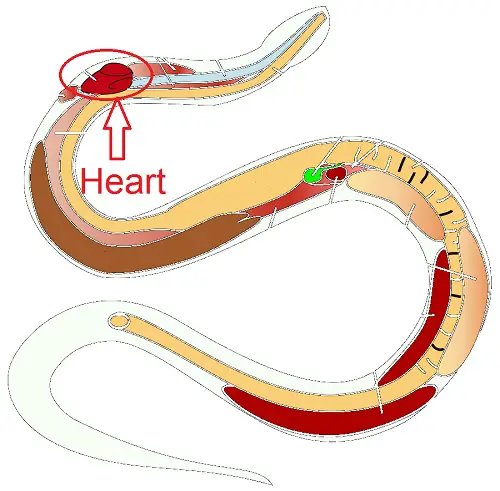Like all other reptiles, snakes have hearts that makes their blood circulate. Blood circulation is vital to snakes because it brings around the nutrients and oxygen that the cells of the snake need to survive!
A snake’s heart is located about one fourth body length down from its head. For snakes that live on the ground, the heart is placed a bit further towards the head and for snakes that tend to climb and live in trees, the heart is positioned somewhat closer to the head.
Snakes are reptiles without legs, so it is sometimes forgotten how much they resemble their lizard cousins.

If you imagine a snake with legs, it is not hard to place the heart. The heart will be in almost the same location as other reptiles (and most other larger animals!) between the front legs.
However, the heart of a snake is not as stationary as in other lizards. In fact, it can move several inches as the snake slithers along its way!
Snakes have a fascinating anatomy, with all its organs placed as on a string in a flexible tube-like reptilian body!
Their long an flexible spine and thin rib structure keeps its organs in place, while facilitating movement.
Some snakes that climb trees (arboreal snakes) have their heart located closer to their heads. This is thought to be because they have to fight gravity to get blood pumped to the head.
Having the heart closer to the head helps the tree climbing snakes to maintain a normal blood pressure in their heads.
However, the reason for the closer placement of the heart in these snakes may not only be due to gravity.
It has also been suggested that the higher placement of the heart is due to the reduced elasticity of blood vessels in tree climbing snakes compared to those on the ground.
Contents
How many heart chambers does a snake have?
Snakes have a heart with only three heart chambers. This is less than mammals and birds, the same as amphibians and more than most fish.
Like in other reptiles (such as geckos, iguanas and turtles), the heart of snakes is also different in its anatomy compared to mammals and in birds.
Apart from the fact that most snakes only have one lung, their heart has only three chambers. This is one less than the mammalian four chambered heart!
Have you ever seen a snake run a marathon? Probably not! They don’t have the heart capacity to do so!

The simplicity of snake hearts makes it unsuitable for extended periods of physical activity. However, a snake rarely needs to move for more than seconds at a time, as this is how snakes hunt.
Snakes either move slowly around or move in short spurts to attack or escape predators – exactly what their circulatory system has evolved to do!
It has evolved for the blood from the tail of the snake to reach the kidneys for filtration before it reaches the heart and gets pumped around the body!
Do snakes have multiple hearts?
No. Snakes only have one heart located a quarter down its body from the head.
However, they might have one or two lungs depending on the species. Smaller snakes such as the corn snake have only one lung, but the larger snakes like the cobra have two lungs.
Snakes do have a long body that may be challenging for one heart to circulate blood through.
But they manage to do so because the movement of their long body/tail also functions as a pump to circulate blood to the heart!
How does a snake heart work?
Snakes have a three-chambered heart, meaning it has two smaller chambers (atria) and one large chamber (ventricle) but only one set of blood vessels that pump blood through the body.
The snake heart looks like it has only three pumping chambers with long tubes that act like one mechanical pump, sending blood to the lungs for oxygenation and back to the body to be delivered to the different cells.
The way the main chamber is constructed with valves and partial divisions, allows it to work almost like a four chambered heart.

Here the septum is illustrated as solid, but is actually icomplete with mixing of the “red” and “blue” blood (with/without oxygen).
However, the blood flowing in to the large chamber will be a mix of blood from the body and the lungs (non-oxygenated and oxygenated blood), which makes it less efficient compared to mammalian and birds hearts.
A unique aspect of the snake’s circulatory system is the renal portal system. This is the system that allows the snake to use its tail as a pump to bring the blood through its kidneys before it reaches its heart and lungs!
This is important knowledge for vets when administering drugs to snakes and other reptiles!
This is because if they inject a snake in its tail, and the drug has to function in e.g. the brain of the snake, much of the drug may be filtered out by the kidneys before it reaches its final destination.
Does a snake heart move?
Yes! The heart of a snake can slide among its other organs to a certain degree. This is possible because the heart is not fastened or locked within a tight ribcage pr diaphragm like in other animals.
The body of a snake has to be very flexible, and organs like the heart have to be able to aside and fit into tight spaces when they eat large prey that has to travel through their bodies!
How fast does a snake’s heart beat?
The resting heart of snakes beats just as fast as most resting humans at an average of around 60 beats per minute!
However, scientists have shown that the actual pulse of a snake depends on the size of the snake and its activity level.
The smaller the snake, the faster its heart beats! And some of the smallest snakes have a heartbeat of up to 75 beats per minute!
And this is probably higher right after they have attacked a prey.
In truth, these numbers are not very high compared to other similarly sized animals in the world.
For example, a rat of a similar weight to a small to medium sized snake has a heart rate of around 270 beats per minute which is almost four times that of the fastest snake heart!
The low pulse of snakes is probably a reflection of their low metabolism, and slow physical movements.
Can you eat a snake heart?
Yes, and some famous chefs have even done that on TV! The meat of snakes is generally not toxic, except the poison glands located in their mouth.
I am not sure how well it tastes though…
Can snakes eat and digest their own hearts?
Yes, if a snake is starving it can digest its own heart tissue. But it does not actually eat it!
Just like other starving animals, the body will at some point start to break down and digest proteins from its own tissues. The heart is usually not first in line for this process also known as “autophagy”.
This is not much different than the breakdown of heart muscles sometimes seen in marathon runners, which takes months to recover completely!
If other muscle tissues are at their minimum and the snake has not had a meal for weeks, the heart may be the last option to survive.
This works only because the heart can tolerate some loss of mass before losing its vital functionality.
Can a snake have a heart attack?
If a coronary artery gets compromised because of infection, the heart of the snake may lose oxygen supply and experience a heart attack.
However, snakes, like most animals, do not generally experience heart attacks. This is partly because they do not eat the same unhealthy diet as humans do, and because the rarely live long enough for their cardiovascular system to fail.
Heart disease is largely a lifestyle disease unique to the suboptimal lifestyle of humans. Animals have many other conditions and threats to worry about…
Can snakes feel love?
Even though snakes have a heart, they do not have feelings like humans do.
They simply do not have the brain structures and hormonal systems to feel affection. They do however feel simple basic emotions like fear, aggression and might even pleasure.

In fact, a recent study found that reptiles such as iguanas, bearded dragons and tortoises mainly feel impulses and emotional states such as: excitement, fear, anxiety, distress, pain, stress, suffering and frustration.
These brain states are believed to be the most basic of emotions, which have been present in animals for millions of years!
This is why the central, most ancient, parts of our brains are often referred to as the “reptile brain”. This brainstem takes care of these fundamental “fight and flight” emotional states rather than more complex emotions such as empathy and love.




